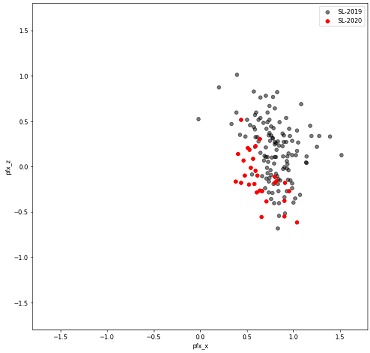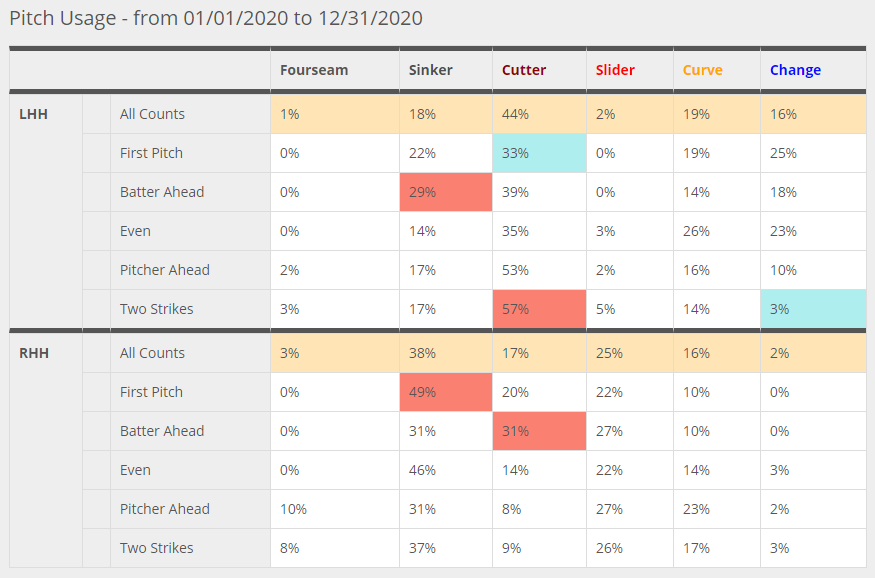There’s been a lot of pitching worth talking about coming out of Cleveland this season. Shane Bieber has emerged with a new cutter that has helped elevate him into ace territory, as evidenced by his 35 Ks in 21.2 innings. Zach Plesac has shown growth through his secondary pitches, which are getting him more whiffs and have already helped him accrue half a win of value after only two starts. Last year, he only tallied one fWAR through 21. And then there’s Aaron Civale, who looks really similar to last year in most respects but is getting results in 2020 that are extremely different.
Civale’s below-average velocity has stayed where it’s always been and he’s still employing a kitchen sink repertoire. He’s still limiting free passes like he has since he became a pro. He’s spinning it at the same plus rate as last year. But now, like so many teammates before him and including the two mentioned above, he’s evolving into more than expected.
| Pitch | % Thrown, 2019 | % Thrown, 2020 |
|---|---|---|
| FA | 3.3 | 30.3 |
| FT | 35.1 | — |
| FC | 29.6 | 28.7 |
| CU | 11 | 16.1 |
| SL | 14.4 | 16.1 |
| CH | 6.6 | 8.2 |
First things first—let’s extinguish a possible red herring. It seems that Civale has transitioned to a four-seamer from a two-seamer. If you’ve been watching his starts or poking around his Statcast page, though, it looks like different classification systems are calling his fastball different things. Whatever it is, the thing that’s actually important is that he’s throwing it about eight percent less now and is redistributing those offerings mostly as curves (up an additional 5.1%). Hold onto that note for later. His cutter and slider usage have remained about the same. Civale is still very much throwing the kitchen sink, but he’s changed how he’s attacking the zone.
For one thing, it takes throwing a pitch about 10% of the time for it to be more than a show-me pitch. While Civale threw as many as six different pitches in 2019, he really only used four in his arsenal. Now he’s pushing five, thanks to the small bump in changeup use. He’s locating the fastball more to his glove side and at the letters. He’s spotting his cutter and changeup just about anywhere he wants. His curve is dipping just below the zone instead of landing at its bottom. The slider is breaking into the lower third of the zone instead of clearly outside of it. This, more than anything, might be the biggest key to what’s different about Civale in 2020. The slide-piece has averaged more than two inches of additional drop through his three starts so far while staying in the zone more. Check out this graphic made by our own Richard Dzeng:

The black dots are Civale’s sliders from 2019. The red ones are his sliders from this year. They all represent vertical drop on the pitch. Nearly all of Civale’s sliders this year are dropping with the oomph of his best ones of last year, but staying in the zone. This is exactly what Daniel Port told us Civale would need to do if he were to take the next step when noting his trajectory has been eerily similar to Corey Kluber.
If you’re wondering how this new slider action might look to a hitter mid-AB, consider how you walk down a flight of stairs. You do it all the time. You almost never even have to look. You’re a total pro. But then one day, one stair is suddenly steeper. It’s just about impossible to not slip and clutch for the railing. That’s about what hitters are doing against Civale’s slider so far, as he’s been using it to catch them off guard. He’s gotten nine called strikes out of 49 sliders thrown this season, good for an 18.4% caught-looking rate. Last year, with 124 sliders thrown, he only generated called strikes on it 12% of the time.
The extra drop Civale is generating on the slider now isn’t the only thing that’s causing trouble, though. Pitches might happen one at a time but they’re never in a vacuum. In speaking with our own Michael Ajeto about the tweak and specifically how hitters would have to try to adjust on the fly against the cutter, he asked, “is [Civale] gonna throw the one that’s 87 with cut? or 82 with drop? It’s gotta be really hard.” For real. Check out this overlay of the two pitches, courtesy of Alex Fast:
https://gfycat.com/uniformnextcivet
Different break, different speeds, almost the exact same spot. Now think about how his curve drops another 8.5 inches than the slider and plops right under the zone. Recall how I said to hold onto how he’s upped his hammer use? The pitch has the kind of action that puts it near the top of the league in break and location, so no wonder why he’s used it more. Try putting yourself in the batter’s box to parse out all of these breakers in real-time, knowing you can’t count on any of them to miss the zone enough to let them go. What a nightmare.
Civale isn’t just using pitch movement to manipulate hitters, though. Remember, he throws the kitchen sink. On top of the slider tweak, he’s completely flipped the script on how he attacks hitters. Last year, dudes could sit first-pitch fastball, and just about sit on a cutter if they got ahead. If he got ahead, it was a little more of a guessing game. Execution was likely relative to really spotting his stuff. But this year, his sequencing is nearly bewildering. Check out these handy charts from Brooks Baseball:

The fastball is only a near-lock to start an at-bat against righties. If either handed batter gets ahead, the next pitch could reasonably be one of four other offerings that are all distinct. If Civale is the one to get ahead in the count, he’s using the mid-breaking slider to push curves to righties and cutters to lefties. While the slider isn’t the pitch that’s generating whiffs, it is helping its companions play up big time. Through his three starts this season, Civale has a 22.4% whiff rate on his curve and 17.2% whiff rate on his cutter. The league average on each of those offerings is barely above 12%. And don’t forget, the slider is stealing strikes above the league average of about 14.5%, too. The sample size is small, but it’s going to be that way all season. Like we talked about with Kyle Lewis last week, a big part of analysis this year could be spotting intent. And it’s hard to think Civale isn’t being intentional, given the noticeable differences in how his stuff looks, the excellent results he’s generated, and his org’s history of rapid, sudden pitcher development.
The improvements Civale has made currently place him seventh in all of baseball in CSW at 36.3%. Last year, he ranked 286th out of 328 pitchers who registered at least 50 innings, at 24.9%. He’s embracing the full scope of his arsenal while getting it over the plate more. His zone rate currently sits at 53.5%, about eight percent more than last year, which takes him from less than average to above it. We can’t just chalk up his hot start to him beating up on weak competition, either. He’s faced the Twins once and White Sox twice in his three outings. Both teams are among the best offenses in baseball.
We might have to wait to confirm it, but Aaron Civale appears to have emerged in 2020 as a legitimate new challenger.
Photo by Nick Wosika/Icon Sportswire | Adapted by (Justin Paradis (@freshmeatcomm on Twitter)
